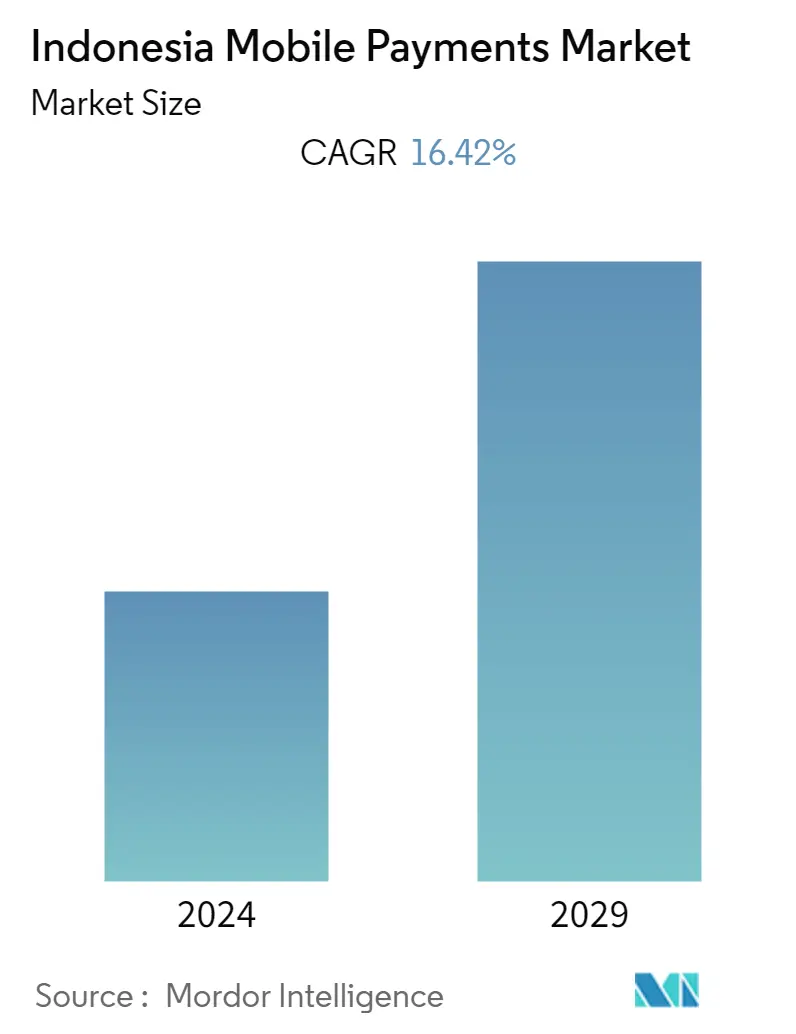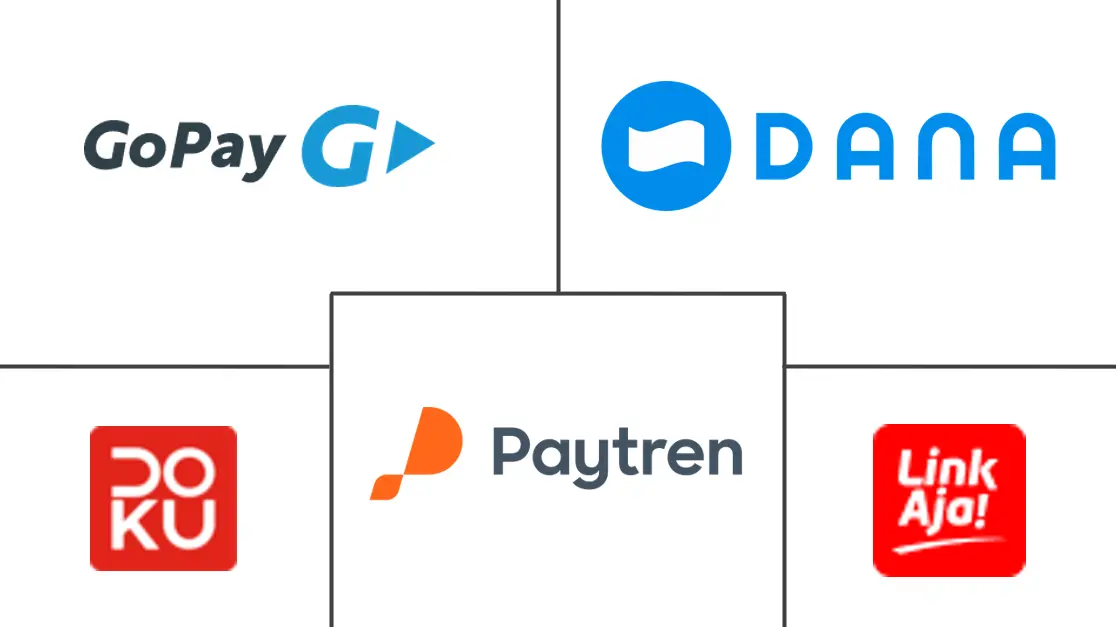Market Size of Indonesia Mobile Payments Industry

| Study Period | 2019 - 2029 |
| Base Year For Estimation | 2023 |
| Forecast Data Period | 2024 - 2029 |
| Historical Data Period | 2019 - 2022 |
| CAGR | 16.42 % |
| Market Concentration | Medium |
Major Players
*Disclaimer: Major Players sorted in no particular order |
Indonesia Mobile Payments Market Analysis
The Indonesia mobile payments market for mobile payments is anticipated to expand at a CAGR of 29.5 percent over the projected period (2022 - 2027). The use of mobile payment systems like Gojek, GoPay S.R.O., DANA, DOKU, and LinkAja by businesses and services nationwide is progressing quickly. This trend is anticipated to persist during the projection period due to rising internet usage and the rapid expansion of online shopping.
- Mobile phones, especially smartphones, have evolved into a necessary component of a person's life as a result of the nation's economy's fast growth. Additionally, the majority of people worldwide now depend on the internet for most of their daily activities. This led to a large surge in the market for mobile payments as smartphones and internet users spread around the region. According to Bank Indonesia, access to financial technology is extensive, with over 10 million fixed-line broadband internet customers and 248.2 million users of 3G and 4G mobile phones.
- Many industry participants, like Gojek, DANA, etc., use reward systems to both retain existing mobile payment service users and attract new ones. In order to facilitate transactions through their applications, several service providers, for instance, provide scratch cards that are loaded with a specific amount. Such compensation schemes encourage customers to use mobile payment apps, which boosts the market for mobile payments.
- The market for mobile payments is expected to expand over the course of the forecast period as a result of the growing popularity of M-commerce, which entails doing online business utilizing wireless devices like smartphones. The world's most mobile-oriented area, according to App Annie's Q3 report for 2021, is Indonesia. Remarkably, Indonesian people spend 5.5 hours every day utilizing mobile apps.
- Additionally, M-commerce enables consumers to transact anywhere there is wireless internet access. Additionally, businesses like LinkAja and Paytren have already debuted their mobile commerce offerings. Customers can now instantly make in-store purchases without the hassle of swiping a card, thanks to the introduction of digital wallets like GoPay, OVO, ShopeePay, etc.
- The market for mobile payments is growing but is being constrained by rising data breaches and security problems. Additionally, due to worries about security and unlawful use of personal data, many customers are hesitant to accept the new technology.
- Customers all across the world started using digital transactions during the COVID-19 epidemic. Customers have access to digital banking systems through several banks and financial institutions. As a result, during the COVID-19 epidemic, mobile payments increased across the nation. As seen in the Indonesian Batik small- and medium-sized enterprise (SME) sector, which was experiencing a shift in modern transaction methods, particularly since the coronavirus outbreak spread in Indonesia, interest in m-payment was growing among consumers and traders because it was a contemporary alternative to debit and credit cards.
Indonesia Mobile Payments Industry Segmentation
Mobile payment is a payment made for a product or service through a portable electronic device such as a tablet or cell phone. The study tracks the application of mobile payment based on transaction type, which is Proximity and Remote payment. The study tracks key market metrics, underlying growth influencers, and significant industry vendors, providing support for Indonesia's mobile payments market estimates and growth rates throughout the anticipated period. The study looks at COVID-19's overall influence on Indonesia's payment ecosystem.
| By Type | |
| Proximity Payment | |
| Remote Payment |
| By End-user Industry | |
| BFSI | |
| IT and Telecommunication | |
| Retail | |
| Healthcare | |
| Government | |
| Media and Entertainment | |
| Transportation and Logistics | |
| Other End-user Industries |
Indonesia Mobile Payments Market Size Summary
The Indonesia mobile payments market is experiencing rapid growth, driven by the increasing adoption of mobile payment systems such as Gojek, GoPay, DANA, DOKU, and LinkAja. This expansion is fueled by the country's burgeoning internet usage and the swift rise of online shopping, making mobile phones, particularly smartphones, an integral part of daily life. The proliferation of internet and smartphone users has significantly boosted the mobile payments sector, with companies employing reward systems to retain and attract users. The market's growth is further supported by the rising popularity of M-commerce, enabling transactions via wireless devices, and the introduction of digital wallets that facilitate seamless in-store purchases.
Despite the promising growth trajectory, the mobile payments market faces challenges, including concerns over data breaches and security issues, which have led to consumer hesitance in adopting new technologies. The COVID-19 pandemic has accelerated the shift towards digital transactions, with increased interest in mobile payments among consumers and traders. The Indonesian government has actively promoted the digital economy, with initiatives like the BI-FAST payment system and the QR Code Indonesian Standard (QRIS) enhancing the digital payment infrastructure. The market is also witnessing significant investments and strategic partnerships, further bolstering the growth of fintech solutions and digital banking services in the region.
Indonesia Mobile Payments Market Size - Table of Contents
-
1. MARKET INSIGHTS
-
1.1 Market Overview
-
1.2 Industry Attractiveness - Porter's Five Forces Analysis
-
1.2.1 Bargaining Power of Suppliers
-
1.2.2 Bargaining Power of Consumers
-
1.2.3 Threat of New Entrants
-
1.2.4 Threat of Substitute Products
-
1.2.5 Intensity of Competitive Rivalry
-
-
1.3 Assessment of Impact of COVID-19 on the Market
-
-
2. MARKET SEGMENTATION
-
2.1 By Type
-
2.1.1 Proximity Payment
-
2.1.2 Remote Payment
-
-
2.2 By End-user Industry
-
2.2.1 BFSI
-
2.2.2 IT and Telecommunication
-
2.2.3 Retail
-
2.2.4 Healthcare
-
2.2.5 Government
-
2.2.6 Media and Entertainment
-
2.2.7 Transportation and Logistics
-
2.2.8 Other End-user Industries
-
-
Indonesia Mobile Payments Market Size FAQs
What is the current Indonesia Mobile Payments Market size?
The Indonesia Mobile Payments Market is projected to register a CAGR of 16.42% during the forecast period (2024-2029)
Who are the key players in Indonesia Mobile Payments Market?
GoPay S.R.O., DANA, DOKU, LinkAja and Paytren are the major companies operating in the Indonesia Mobile Payments Market.

